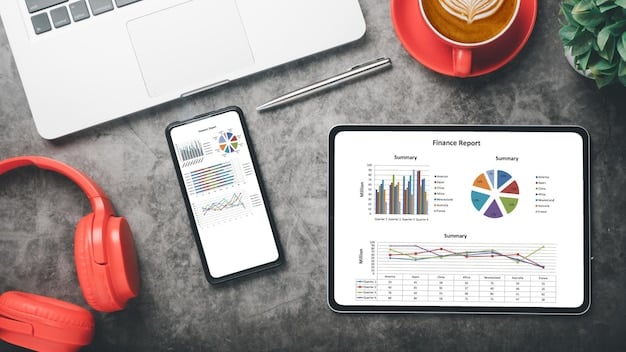Data Analytics for Digital Marketing: Boost Campaigns by 10%

Data Analytics for Digital Marketing: Track Your Progress and Optimize Your Campaigns for a 10% Gain involves leveraging data to understand customer behavior, refine marketing strategies, and ultimately achieve a measurable 10% improvement in campaign performance through informed decision-making.
Are you ready to unlock the power of data and elevate your digital marketing game? In today’s hyper-competitive landscape, simply relying on intuition is no longer enough. To truly succeed, you need to harness the power of data analytics to understand your audience, optimize your campaigns, and drive measurable results. This guide will show you how to use data analytics for digital marketing: track your progress and optimize your campaigns for a 10% gain.
By implementing effective data analysis strategies, you can gain valuable insights into what’s working and what’s not, allowing you to make data-driven decisions that lead to a 10% gain in your marketing performance. Let’s dive in and explore how data analytics for digital marketing: track your progress and optimize your campaigns for a 10% gain can transform your approach and deliver tangible success.
Understanding the Fundamentals of Data Analytics in Digital Marketing
Data analytics forms the bedrock of modern digital marketing, enabling marketers to make informed decisions based on concrete data rather than guesswork. By tracking and analyzing key performance indicators (KPIs), businesses can gain a deeper understanding of their audience, campaign effectiveness, and overall marketing performance.
Key Metrics to Track
Identifying and tracking the right metrics is crucial for effective data analytics. These metrics provide insights into various aspects of your digital marketing efforts, helping you understand what’s working and what’s not.
- Conversion Rates: Measuring the percentage of visitors who complete a desired action, such as making a purchase or filling out a form.
- Website Traffic: Monitoring the number of visitors to your website and their behavior, including bounce rates and time spent on pages.
- Engagement Metrics: Analyzing social media interactions, such as likes, shares, and comments, to gauge audience interest.
- Customer Acquisition Cost (CAC): Calculating the cost of acquiring a new customer through various marketing channels.
Tracking these metrics allows you to pinpoint areas for improvement and optimize your strategies accordingly. Using data analytics for digital marketing: track your progress and optimize your campaigns for a 10% gain is about understanding these metrics and acting upon the insights they provide.

Tools for Data Analysis
Leveraging the right tools can significantly streamline your data analysis efforts. These tools provide the capabilities needed to collect, analyze, and visualize data, making it easier to identify patterns and trends.
- Google Analytics: A free web analytics service that tracks and reports website traffic, user behavior, and conversion rates.
- социальных сетях Analytics: Provides detailed insights into social media performance, including engagement metrics and audience demographics.
- HubSpot: A comprehensive marketing automation platform that includes analytics tools for tracking email campaigns, website performance, and lead generation.
- Tableau: A data visualization tool that allows you to create interactive dashboards and reports to present your findings in a clear and compelling manner.
These tools are indispensable for data analytics for digital marketing: track your progress and optimize your campaigns for a 10% gain. By using them effectively, you can uncover valuable insights that drive better marketing outcomes.
In conclusion, understanding the fundamentals of data analytics, tracking the right metrics, and utilizing the appropriate tools are essential steps in optimizing your digital marketing campaigns. This foundation will enable you to make informed decisions that lead to measurable improvements.
Implementing Data-Driven Strategies for a 10% Gain
Once you have a solid understanding of data analytics principles, the next step is to implement data-driven strategies to achieve a tangible 10% gain in your marketing performance. This involves using data insights to refine your targeting, personalize your messaging, and optimize your campaigns for maximum impact.
Refining Targeting with Data
Data can help you identify your most valuable audience segments and tailor your marketing efforts to reach them more effectively. By analyzing demographic data, behavioral patterns, and customer preferences, you can create highly targeted campaigns that resonate with specific groups.
For example, if your data reveals that a significant portion of your customer base is located in a particular geographic region or has a specific interest, you can create targeted ads and content that cater to their unique needs. This approach ensures that your marketing messages are relevant and engaging, increasing the likelihood of conversions.
Personalizing Marketing Messages
Personalization is a powerful tool for enhancing customer engagement and driving conversions. By using data to understand individual customer preferences and behaviors, you can create personalized marketing messages that resonate with them on a deeper level.
This can involve tailoring email campaigns to include personalized product recommendations, creating dynamic website content that changes based on user behavior, or delivering targeted ads that address specific customer needs. In achieving data analytics for digital marketing: track your progress and optimize your campaigns for a 10% gain, personalization can improve customer satisfaction.
A/B Testing and Continuous Optimization
A/B testing is a systematic approach to optimizing your marketing campaigns by comparing different versions of an ad, landing page, or email to see which performs better. By continuously testing and refining your marketing elements, you can identify the most effective strategies and improve your overall results.
- Test different headlines, images, and calls-to-action to see which combinations resonate best with your audience.
- Experiment with different landing page layouts and content to optimize conversion rates.
- Analyze the results of your A/B tests and use the insights to make data-driven decisions about your marketing strategy.
By implementing data-driven strategies, refining your targeting, personalizing your messaging, and continuously optimizing your campaigns, you can expect to realize a 10% gain in your marketing performance. This approach ensures that your marketing efforts are aligned with customer needs and preferences, leading to improved results and a higher return on investment.

Real-World Examples of Data Analytics Success
Many businesses have successfully leveraged the power of data analytics to achieve significant improvements in their digital marketing performance. These real-world examples demonstrate how data-driven strategies can lead to increased conversions, improved customer engagement, and a higher return on investment. To implement data analytics for digital marketing: track your progress and optimize your campaigns for a 10% gain, consider the subsequent real-world examples of Data Analytics success.
Case Study 1: E-Commerce Conversion Boost
An e-commerce company increased its conversion rate by 15% by using data analytics to personalize product recommendations. By analyzing customer purchase history, browsing behavior, and demographic data, the company was able to identify the most relevant products for each customer and display them in personalized recommendations on their website and in email campaigns.
This approach resulted in a significant increase in sales and customer satisfaction, demonstrating the power of personalization in driving e-commerce success.
Case Study 2: Social Media Engagement Surge
A social media marketing agency boosted engagement for a client by 20% by using data analytics to identify the most engaging content formats and topics. By tracking metrics such as likes, shares, comments, and click-through rates, the agency was able to determine which types of content resonated best with the client’s target audience.
They then created a content strategy that focused on these engaging formats and topics, resulting in a significant increase in social media engagement and brand awareness. To execute data analytics for digital marketing: track your progress and optimize your campaigns for a 10% gain it is of utter importance to analyze historical data.
How to Apply These Lessons
These case studies illustrate the importance of data analytics in achieving digital marketing success. By implementing data-driven strategies, you can personalize your marketing messages, optimize your content, and improve your overall results.
- Analyze your customer data to identify patterns and insights that can inform your marketing strategy.
- Use personalization to create targeted marketing messages that resonate with your audience.
- Continuously track and analyze your marketing performance to identify areas for improvement.
Ultimately, the key to success with data analytics is to use the insights you gain to make informed decisions about your marketing strategy and continually optimize your campaigns for maximum impact.
Common Pitfalls and How to Avoid Them
While data analytics can be a powerful tool for improving digital marketing performance, it’s important to be aware of the common pitfalls that can hinder your success. By understanding these challenges and implementing strategies to avoid them, you can ensure that your data analytics efforts are effective and yield valuable insights.
Data Overload
One of the most common challenges in data analytics is data overload – the situation where you have so much data that it becomes difficult to extract meaningful insights. This can lead to analysis paralysis and make it difficult to make data-driven decisions.
To avoid data overload, it’s important to focus on the metrics that are most relevant to your marketing goals and prioritize your analysis efforts accordingly. Don’t try to analyze every piece of data available to you – instead, focus on the key performance indicators (KPIs) that will help you understand your progress and optimize your campaigns. In executing data analytics for digital marketing: track your progress and optimize your campaigns for a 10% gain, you must be wary of becoming overwhelmed by the data itself.
Misinterpreting Data
Another common pitfall is misinterpreting data, which can lead to incorrect conclusions and misguided marketing decisions. This can happen if you don’t have a clear understanding of the data or if you make assumptions that are not supported by the evidence.
To avoid misinterpreting data, it’s important to have a strong foundation in statistics and data analysis techniques. You should also be careful to validate your findings with additional data and seek input from other experts to ensure that your conclusions are accurate.
Ignoring Qualitative Data
While quantitative data (such as website traffic and conversion rates) is valuable, it’s also important to consider qualitative data (such as customer feedback and reviews). Ignoring qualitative data can lead to an incomplete understanding of your audience and their needs.
To get a complete picture, you should combine quantitative and qualitative data in your analysis efforts. Use qualitative data to understand the “why” behind the numbers and to identify opportunities for improvement that may not be apparent from the quantitative data alone.
By being aware of these common pitfalls and implementing strategies to avoid them, you can ensure that your data analytics efforts are effective and yield valuable insights that drive better marketing results. Utilizing data analytics for digital marketing: track your progress and optimize your campaigns for a 10% gain is only as good as the insights one is able to extract.
Future Trends in Data Analytics for Marketing
The field of data analytics is constantly evolving, with new technologies and techniques emerging all the time. Staying ahead of these trends is essential for marketers who want to leverage the power of data to drive their marketing efforts.
Artificial Intelligence and Machine Learning
Artificial intelligence (AI) and machine learning (ML) are poised to revolutionize the field of data analytics. These technologies can automate many of the tasks involved in data analysis, such as data collection, cleaning, and interpretation, freeing up marketers to focus on more strategic activities.
AI and ML can also be used to identify patterns and insights that would be difficult or impossible for humans to detect, enabling marketers to make more informed decisions and personalize their marketing messages more effectively.
Predictive Analytics
Predictive analytics involves using data to forecast future outcomes, such as customer behavior, market trends, and campaign performance. This can help marketers make proactive decisions and optimize their strategies to maximize their results. To achieve data analytics for digital marketing: track your progress and optimize your campaigns for a 10% gain, it is important to begin considering predictive analytics.
For example, predictive analytics can be used to identify customers who are likely to churn, allowing marketers to take steps to retain them. It can also be used to predict which ad creatives will perform best, enabling marketers to optimize their ad campaigns for maximum impact.
Enhanced Data Privacy Measures
With increasing concerns about data privacy, marketers need to be aware of the evolving regulations and best practices for protecting customer data. This includes implementing robust data security measures, obtaining consent for data collection, and being transparent about how data is used.
By embracing these future trends, marketers can unlock new opportunities for improving their marketing performance and delivering more value to their customers. Data analytics for digital marketing: track your progress and optimize your campaigns for a 10% gain is an evolving field with innovative technologies that promise to revolutionize and drastically improve marketing decision.
| Key Point | Brief Description |
|---|---|
| 📊 Metric Tracking | Essential for understanding campaign performance. |
| 🎯 Refined Targeting | Improves relevance and engagement. |
| 🤖 AI Integration | Automates and enhances data analysis. |
Frequently Asked Questions
Data analytics helps improve marketing ROI by identifying effective strategies, optimizing campaigns, and personalizing customer experiences, leading to increased conversions and revenue.
Primary data sources include website analytics, social media analytics, email marketing data, CRM systems, and advertising platforms.
Yes, small businesses can greatly benefit by understanding customer behavior, optimizing limited resources, and improving marketing effectiveness through data-driven decisions.
Key challenges include data overload, lack of skilled analysts, ensuring data privacy, and integrating data from various sources.
Data visualization helps in presenting complex data in an easily understandable format, enabling marketers to quickly identify trends and make informed decisions.
Conclusion
In conclusion, mastering data analytics for digital marketing: track your progress and optimize your campaigns for a 10% gain is no longer an option but a necessity for success. By implementing the strategies and techniques outlined in this guide, you can harness the power of data to drive measurable improvements in your marketing performance.





